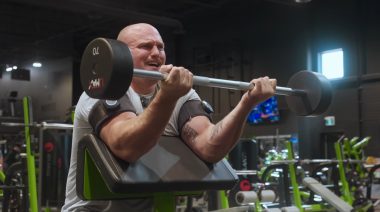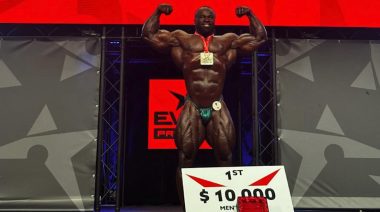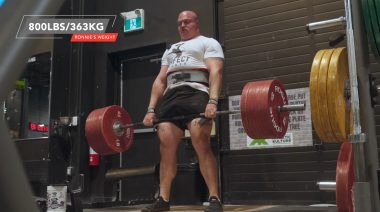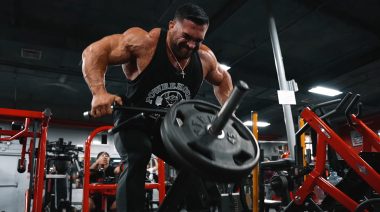The biggest obstacle most lifters face has nothing to do with heavy weights, exercise technique, or anything in the gym. Plenty of people tackle their workouts with plenty of focus, discipline, and enthusiasm. The trouble is most don’t run into trouble in the squat rack as often as they do in the fridge.
Let’s be honest: Nutrition is often less glamorous than training. Straining and grinding in the gym is more appealing than deciding whether you should have the double-chicken burrito bowl with half rice and half beans or the double-steak burrito with no rice and extra guac.

Plenty of well-designed training plans have been steered off-track because they weren’t supported by an equally well-designed nutrition plan.
Getting enough calories, carbs, protein, and fats can mean the difference between packing on size and hitting PRs or spinning your wheels and burning out. Here’s how to set up a “diet plan” that will help you build muscle and move heavier weights.
- Find Your Calorie Requirements
- Macros for Muscle and Strength
- Meal Timing and Frequency
- The Anabolic Window Myth
- Tips to Eat for Muscle and Strength
Calorie Requirements
Your total calorie intake is the be-all, end-all of gaining muscular body weight. No matter how finely tuned your workout program is, no matter how many grams of protein you’re eating every day, if your total calories are lacking, your body simply won’t have the raw materials to create new muscle tissue. (1)
Fortunately, nudging your body into growth-mode doesn’t have to involve 10-egg omelets, straight olive oil shooters, or gut-busting blender bombs loaded with peanut butter, oats, and whole milk. You can flip the muscle-building switch by adding roughly 300 to 500 calories per day. (2)
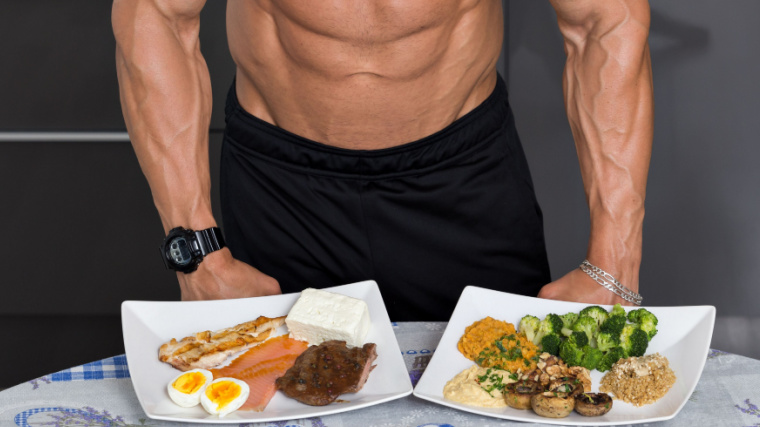
It could be as simple as eating your standard menu and adding one big glass of milk with an extra scoop of protein powder or having an after-lunch snack of a tuna salad sandwich and an apple. While that might not sound like some people’s idea of a traditional “bulking diet,” it’s a ballpark number that reinforces your ability to tackle the hardest training sessions, lift heavier, recover more completely, and build lean body mass (muscle). (3)
Perhaps more importantly, this surplus intake can also help to avoid potential drawbacks from training with insufficient calories. Too much training on too few calories can affect everything from workout recovery and performance to hormone levels and cardiovascular health. (4)
Just be sure not to tip the scales, literally, too far in your pursuit of size. Research has shown that a caloric surplus can be beneficial for size and strength, but there’s a point of diminishing returns where you gain more body fat than muscle, and strength gains won’t keep pace with your increasing body weight, which reduces your overall power and relative strength. (1)
To stay in the “enough, but not too much” zone, you’ll want to do a little math. Your body weight (in pounds) x 25 is a rough guideline to find your maximum intake. Anything beyond that point is likely going to push you into the red zone of low-quality gains.
Start with a more reasonable and sustainable addition of just a few hundred calories on top of your current daily diet and monitor your progress to adjust weekly or biweekly as needed.
Macros for Muscle and Strength
If calories were a sports car, macronutrients would be the tires, steering wheel, and engine — protein, carbohydrates, and fats are three essential components that determine whether or not you’ll actually get you where you want to go.
Every gram of protein and carbohydrate each contain four calories, while every gram of fat contains nine calories. While you might instinctively think “more fats equals more calories equals more size,” it’s not that simple.
Specific attention to your macronutrient breakdown will determine if your increased body weight comes from gaining lean muscle mass or simply gaining body fat. (5)
Protein
Protein is fundamentally “the muscle macro.” It’s composed of amino acids which are required for creating new muscle tissue. In fact, muscle protein synthesis and muscle protein breakdown are the two primary processes triggered by weight training which will determine whether or not you build muscle. (6)
Because protein plays such a significant role in muscle-building, it’s critical that you take in enough each day. One gram of protein per pound of bodyweight is a long-touted guideline for daily intake. Although an abundance of research suggests a more accurate .74 grams per pound of bodyweight to be the upper limit, beyond which, higher protein intake doesn’t trigger any additional growth.(7)
Sorry carnivores, but triple-bodyweight protein intake won’t lead to triple the gains. However, interestingly, when a calorie surplus includes a very high protein intake, the protein was shown to have what researchers called “a protective effect against fat gain during times of energy surplus.” (5) Translation: high calories with high protein leads to muscle growth and relatively less fat gain.
While animal-based products (meat, poultry, fish, eggs, and dairy) are the most common and most efficiently absorbed sources of protein, vegan and vegetarian foods have shown to be equally effective for supporting performance and recovery, but slightly less efficient for supporting muscle growth. (8)
Carbohydrates
Some nutrition plans manipulate carbohydrates because it can be an efficient way to trigger fat loss, but when it comes to building muscle and fueling weight training workouts, carbs are sometimes not given particular attention.
Having ample carbs throughout the day can support muscle growth by decreasing muscle protein breakdown. Carbs also provide energy and endurance during relatively high volume training (plenty of exercises, sets, and/or reps). (9)

Ideally, aim for a total carb intake of two to three grams per pound of bodyweight per day to support performance, growth, and recovery. (10) If you’re weight training five or more days per week, lean towards a higher intake. If you’re training less often or following a low-volume training plan, your needs will be relatively lower.
While the majority of your carbs should come from whole-food sources like grains, legumes, tubers, and fruit, you should monitor the intake of simple carbs (sugar). Particularly when combined with excess calories, relatively high sugar intake is associated with fat gain. Keeping your simple sugar intake to roughly 10% of your daily calories will work towards minimizing this unwanted gain. (11)
Fats
Because they’re the most calorie-dense macronutrient, dietary fats require a keen approach when you’re increasing calories. It’s dangerously easy to overflow your calorie intake from excessively high fats.
Certain types of fats, specifically Omega-3s found in fish, have been shown to support muscle protein synthesis which can lead to more muscle growth. (12) Adequate fat intake is also important for supporting hormone levels, cardiovascular health, and your immune system. (13)
As part of a muscle-building, strength-boosting plan, aim to keep your fat intake 30% to 40% of your total daily calories. For example, if you’re eating 3,000 calories per day, that’s 900 to 1200 calories from fat. Because one gram of fat contains nine calories, it ends up at roughly 100 to 130 grams per day.
For optimal results, stick with natural animal fats (those found in animal-based protein sources), as well as nuts, olives, avocados, and coconuts. Overly processed liquid fats, like many bottled vegetable oils, can be counterproductive for long-term health and performance.
Meal Timing and Frequency
Three big, hearty meals per day has been a time-tested approach for old school bodybuilders, strongmen, and strength athletes. Eating smaller meals more frequently — as often as every two or three hours — is a relatively new approach modern lifters have had some success with.
A higher meal frequency is typically associated with fat loss plans, though it’s debatably effective. (14) The concept can also be applied to lifters wanting to gain muscular body weight.

One significant factor is the individual’s habits, mindset, and overall digestion. Some lifters find it more practical to eat three relatively large meals per day, while others may have trouble regaining their appetite for lunch several hours after a big breakfast.
In the latter case, eating fewer calories more often is a way to reach the daily calorie target with minimal discomfort. The compromise with high-frequency meals is the necessity of interrupting your daily routine on a consistent basis to unpack and inhale a small meal.
Both methods can be effective as long as they deliver the target daily nutrition. However, extremely low-frequency eating — one or two meals per day — can make it more challenging to reach the daily calorie and macro goal. This reduced meal approach is also less efficient for stimulating protein synthesis, which makes it less effective for building muscle. (15)
The Anabolic Window Myth
Most experienced lifters have heard about “the anabolic window” — the crucial time period immediately after weight training where your body has been stimulated to such a degree that it will transmogrify any and all calories into heaps of new muscle tissue.
Bodybuilders in the 1950s would drink whole milk during their workouts, hardcore powerlifters have eaten peanut butter and jelly sandwiches between sets, and modern day lifters would sip on half-gallon concoctions of the latest scientific formulas. All in the hopes of catching the crucial window.
While it’s true that your body is in a highly responsive state during and immediately after a training session, it isn’t nearly as narrow as the “90 minutes or less” mantra that echoes through the gym.

Having protein during a workout was shown to decrease muscle protein breakdown (a good thing for growth). (16) However, rather than a slim 60 or 90-minute “window,” a large amount of research supports a more broad approach that’s highly effective. Having a meal (or drink) containing protein and carbs within a six-hour window of your workout can efficiently maximize muscle protein synthesis and support optimal recovery. (17)
In fact, your body remains ready to efficiently put nutrients to use for recovery and growth for up to 24 hours after hard training. You could, in theory, neglect the “anabolic window” entirely, eat your standard meals at your standard times, and use those protein and carb-laden calories for muscle-building.
Many lifters find their appetite stimulated by intense training, and they tend to drink water during their workouts. Both are quick and simple opportunities to add quality calories to your day with minimal effort and maximum benefit.
Serious Training Needs Serious Eating
If you want maximum results, you can’t just hit it hard in the gym and slack off when you head to your car. At best, you’ll end up spinning your wheels and struggling unnecessarily for every drop of progress. At worst, you’ll end up going backwards because poor recovery will make your workouts harder and harder. If your goals include adding lean muscle and hitting big lifts, you won’t get there until you treat the spice rack as seriously as the squat rack.
Tips to Eat for Muscle and Strength
Still trying to skip the “boring nutrition stuff” and just want some quick takeaway points? No problem. Here are some ‘just do these’ ideas to kickstart new growth and bigger gains.
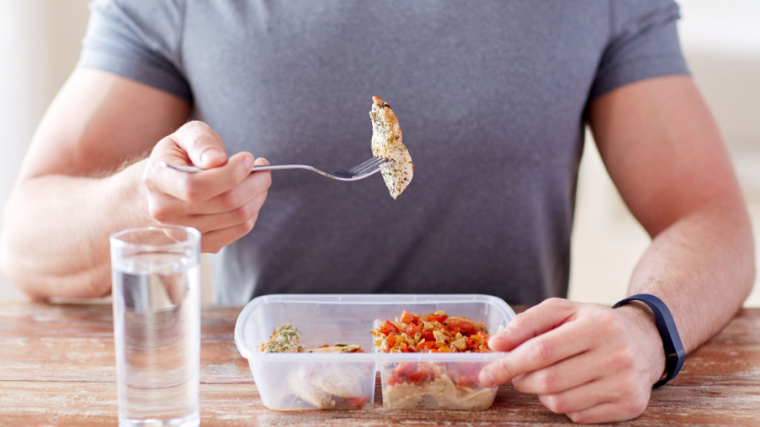
- Building muscle doesn’t mean gorging. Add 300 to 500 calories per day, mostly from protein. Track progress before adding more calories.
- Know your body and your appetite. Either plan on having “breakfast, lunch, workout shake, and dinner” or eat smaller meals five to seven times per day (having food every two to three hours). Your total calories should remain the same.
- Aim for one gram of protein per pound of bodyweight. Having slightly less is still effective. Eating a bit more protein won’t build“extra muscle,” but may potentially fight against fat gain.
- Aim for two to three grams of carbs per pound of bodyweight, primarily from whole-food sources and relatively low sugar. Using soda and candy as caloric filler may only hurt your physique.
- Set your dietary fat intake at 30% to 40% of your total daily calories, most of which will likely come naturally from your protein sources.
- For maximum results, have a pre-workout meal within three hours of starting your workout, drink protein and carbohydrates during training, and have a post-workout meal within three hours of ending your workout.
References
- Ribeiro, A. S., Nunes, J. P., Schoenfeld, B. J., Aguiar, A. F., & Cyrino, E. S. (2019). Effects of Different Dietary Energy Intake Following Resistance Training on Muscle Mass and Body Fat in Bodybuilders: A Pilot Study. Journal of human kinetics, 70, 125–134. https://doi.org/10.2478/hukin-2019-0038
- Slater, G. J., Dieter, B. P., Marsh, D. J., Helms, E. R., Shaw, G., & Iraki, J. (2019). Is an Energy Surplus Required to Maximize Skeletal Muscle Hypertrophy Associated With Resistance Training. Frontiers in nutrition, 6, 131. https://doi.org/10.3389/fnut.2019.00131
- Garthe, I., Raastad, T., Refsnes, P. E., & Sundgot-Borgen, J. (2013). Effect of nutritional intervention on body composition and performance in elite athletes. European journal of sport science, 13(3), 295–303. https://doi.org/10.1080/17461391.2011.643923
- Melin, A. K., Heikura, I. A., Tenforde, A., & Mountjoy, M. (2019). Energy Availability in Athletics: Health, Performance, and Physique. International journal of sport nutrition and exercise metabolism, 29(2), 152–164. https://doi.org/10.1123/ijsnem.2018-0201
- Leaf, A., & Antonio, J. (2017). The Effects of Overfeeding on Body Composition: The Role of Macronutrient Composition – A Narrative Review. International journal of exercise science, 10(8), 1275–1296.
- Stokes, T., Hector, A. J., Morton, R. W., McGlory, C., & Phillips, S. M. (2018). Recent Perspectives Regarding the Role of Dietary Protein for the Promotion of Muscle Hypertrophy with Resistance Exercise Training. Nutrients, 10(2), 180. https://doi.org/10.3390/nu10020180
- Morton, R. W., Murphy, K. T., McKellar, S. R., Schoenfeld, B. J., Henselmans, M., Helms, E., Aragon, A. A., Devries, M. C., Banfield, L., Krieger, J. W., & Phillips, S. M. (2018). A systematic review, meta-analysis and meta-regression of the effect of protein supplementation on resistance training-induced gains in muscle mass and strength in healthy adults. British journal of sports medicine, 52(6), 376–384. https://doi.org/10.1136/bjsports-2017-097608
- Pohl, A., Schünemann, F., Bersiner, K., & Gehlert, S. (2021). The Impact of Vegan and Vegetarian Diets on Physical Performance and Molecular Signaling in Skeletal Muscle. Nutrients, 13(11), 3884. https://doi.org/10.3390/nu13113884
- Mata, F., Valenzuela, P. L., Gimenez, J., Tur, C., Ferreria, D., Domínguez, R., Sanchez-Oliver, A. J., & Martínez Sanz, J. M. (2019). Carbohydrate Availability and Physical Performance: Physiological Overview and Practical Recommendations. Nutrients, 11(5), 1084. https://doi.org/10.3390/nu11051084
- Richard B Kreider, Colin D Wilborn, Lem Taylor, Bill Campbell, Anthony L Almada, Rick Collins, Mathew Cooke, Conrad P Earnest, Mike Greenwood, Douglas S Kalman, Chad M Kerksick, Susan M Kleiner, Brian Leutholtz, Hector Lopez, Lonnie M Lowery, Ron Mendel, Abbie Smith, Marie Spano, Robert Wildman, Darryn S Willoughby, Tim N Ziegenfuss & Jose Antonio (2010) ISSN exercise & sport nutrition review: research & recommendations, Journal of the International Society of Sports Nutrition, 7:1, DOI: 10.1186/1550-2783-7-7
- Te Morenga L, Mallard S, Mann J. Dietary sugars and body weight: systematic review and meta-analyses of randomised controlled trials and cohort studies BMJ 2013; 346 :e7492 doi:10.1136/bmj.e7492
- Gordon I. Smith, Philip Atherton, Dominic N. Reeds, B. Selma Mohammed, Debbie Rankin, Michael J. Rennie, Bettina Mittendorfer; Omega-3 polyunsaturated fatty acids augment the muscle protein anabolic response to hyperinsulinaemia–hyperaminoacidaemia in healthy young and middle-aged men and women. Clin Sci (Lond) 1 September 2011; 121 (6): 267–278. doi: https://doi.org/10.1042/CS20100597
- Venkatraman JT, Leddy J, Pendergast D. Dietary fats and immune status in athletes: clinical implications. Medicine and Science in Sports and Exercise. 2000 Jul;32(7 Suppl):S389-95. DOI: 10.1097/00005768-200007001-00003. PMID: 10910295.
- Schoenfeld, B. J., Aragon, A. A., & Krieger, J. W. (2015). Effects of meal frequency on weight loss and body composition: a meta-analysis. Nutrition reviews, 73(2), 69–82. https://doi.org/10.1093/nutrit/nuu017
- Schoenfeld, B.J., Aragon, A.A. How much protein can the body use in a single meal for muscle-building? Implications for daily protein distribution. J Int Soc Sports Nutr 15, 10 (2018). https://doi.org/10.1186/s12970-018-0215-1
- Greenhaff, P. L., Karagounis, L. G., Peirce, N., Simpson, E. J., Hazell, M., Layfield, R., Wackerhage, H., Smith, K., Atherton, P., Selby, A., & Rennie, M. J. (2008). Disassociation between the effects of amino acids and insulin on signaling, ubiquitin ligases, and protein turnover in human muscle. American journal of physiology. Endocrinology and metabolism, 295(3), E595–E604. https://doi.org/10.1152/ajpendo.90411.2008
- Schoenfeld, B. J., & Aragon, A. A. (2018). Is There a Postworkout Anabolic Window of Opportunity for Nutrient Consumption? Clearing up Controversies. The Journal of orthopaedic and sports physical therapy, 48(12), 911–914. https://doi.org/10.2519/jospt.2018.0615
Featured Image: Jacob Lund / Shutterstock

